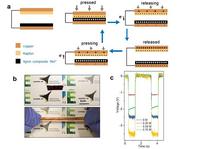Wu Group lignin research published
APL Materials recently published the Wu Group's research on a lignin biopolymer based energy harvesting device in a paper entitled “Lignin biopolymer based triboelectric nanogenerators”.
"This paper reports our progress in transforming the otherwise wasted lignin (despite that it is the second most abundant biopolymer on earth) into a functional device that can convert human motion into electricity," explained Asst. Professor Wenzhuo Wu of Purdue IE's Nanosystems & Nanomanufacturing Lab.
PhD student Ruoxing Wang conducted the research along with West Lafayette high-school student Yukai Bao. In early 2016, Bao had contacted Wu about working in his lab, which she has done since last summer.
Ongoing research in triboelectric nanogenerators (TENGs) focuses on increasing power generation, but obstacles concerning economical and eco-friendly utilization of TENGs continue to prevail. Being the second most abundant biopolymer on earth, lignin offers a valuable opportunity for low-cost TENG applications in biomedical devices, benefitting from its biodegradability and biocompatibility. Here, we develop for the first time a lignin biopolymer based TENG for harvesting mechanical energy in the environment, which shows great potential for self-powered biomedical devices among other applications and opens doors to new technologies that utilize otherwise wasted materials for economically feasible and ecologically friendly production of energy devices.

